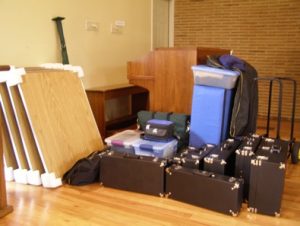“English” handbells are a type of bell, like a “French” horn is a type of horn. The two brands of English handbells you’ll probably consider for solo work are both made in the U.S., by Schulmerich (the older of the two) and Malmark (founded by someone who left Schulmerich and implemented new ideas about handbells). Continue reading Buying bells: choosing a brand
Category Archives: Equipment
Buying bells: whether to buy, which range to buy, bell cases
I’ve been contacted by several people in recent weeks for advice about buying or selling bells. Though I’m not a professional appraiser or broker, I have some information to share that you may find helpful, whether as a buyer or a seller. I’ll address the needs of soloists first, and the needs of groups (like a church) in a later post. In a future post, I’ll also talk about selling secondhand bells. Continue reading Buying bells: whether to buy, which range to buy, bell cases
Marking bell equipment
It’s a good idea to mark bells both visibly (so you know which are yours at a handbell conference) and invisibly (so you can prove stolen bells belong to you if the police recover them, or if they show up on eBay). I’ll talk about how to do both, as well as marking other equipment. Marking all your equipment is a critical part of preparing for your first handbell event, or a concert with other handbell musicians. Continue reading Marking bell equipment
Insurance: property
Congratulations! You’re a handbell owner! Chances are, you waited a long time for this, and now you want to protect your investment. Insurance may play a part in this. Continue reading Insurance: property
Mallets
Mallets are an external clapper mechanism. They can be used to create either a stopped sound (malleting bells on the table) or a sustained sound (malleting bells in the air, either singly or in bell trees). The object is to produce the same timbre as the clapper would. Bell manufacturers provide a variety of mallets intended for particular ranges of bells. In general, the bigger the bell, the bigger and softer the mallet. The mallets may be covered with yarn or other soft material. Smaller bells call for smaller, harder mallets, often made of rubber or plastic. Continue reading Mallets
Bell trees: equipment
The standard range for bell tree pieces using current methods is G4-G7. It’s possible to play with a much smaller range, and you could start with C5-C7 or even fewer bells. For example, the popular ‘Symphonia on Hyfrydol’ uses only C6-D7 (with F7, which could be left out) in the solo version of the bell tree part. Continue reading Bell trees: equipment
Small stuff
Being a concert solo handbell artist isn’t cheap. I’ll write another time about the major investments in equipment (like bells) and training required for a serious study of this instrument. Today’s article is about the astonishing array of “small stuff” I’ve acquired in my work as a handbell soloist. (And not so small stuff – the Bellmobile and piano both made the list!) Continue reading Small stuff
Practicing without bells
Handbell musicians usually start learning the instrument without owning it. The bells may belong to your church, school, or community organization, and a single weekly rehearsal isn’t enough to learn to play any instrument well. It helps to study your sheet music at home, with the director’s permission, and to obtain recordings you can listen to in your car. Continue reading Practicing without bells
Concert equipment and transport
 The amount of equipment required is one of the limiting factors in solo handbell performances, and it took a while to sort out the best way to handle it all. For one of my concerts, I transported everything shown here surrounding the organ console and bench. Continue reading Concert equipment and transport
The amount of equipment required is one of the limiting factors in solo handbell performances, and it took a while to sort out the best way to handle it all. For one of my concerts, I transported everything shown here surrounding the organ console and bench. Continue reading Concert equipment and transport
Hearing protection
Hearing is a musician’s most important asset. As handbell musicians, and especially as soloists, we routinely put a loud, high-pitched instrument near our ears. We may rehearse in a room that reflects sound back at us, or in a row in front of other handbell musicians. We need to think early in our musical journey about protecting our hearing. It’s particularly important for advanced ringers, who may be exposed to more four-in-hand techniques in the high treble, and for those ringing bell trees. Bells on bell trees aren’t generally damped, so there’s an accumulation of sound right at ear level. Church ringers may need to think about protecting their hearing at Easter, where brass instruments may be combined with the bell choir, perhaps playing behind them. Continue reading Hearing protection